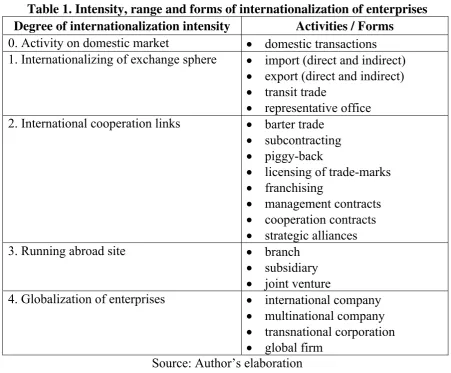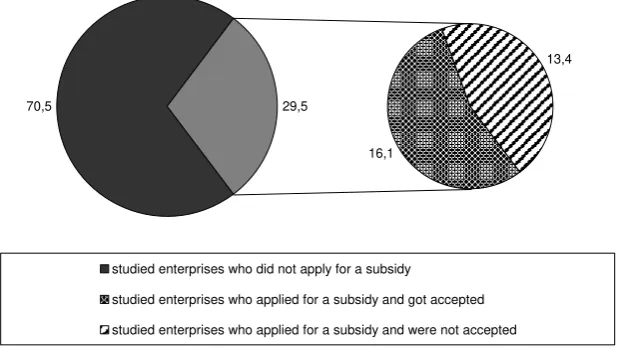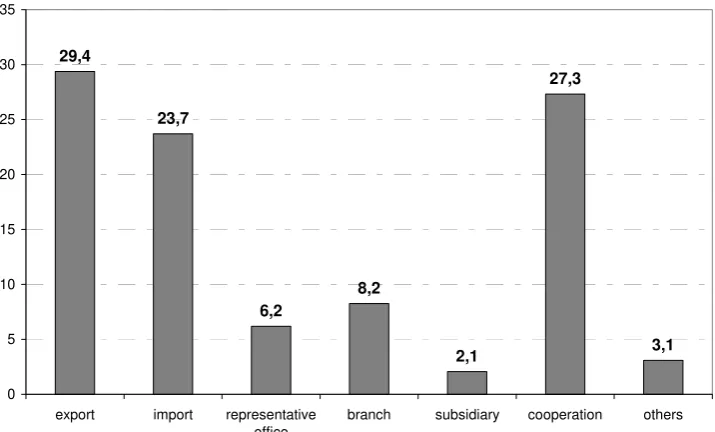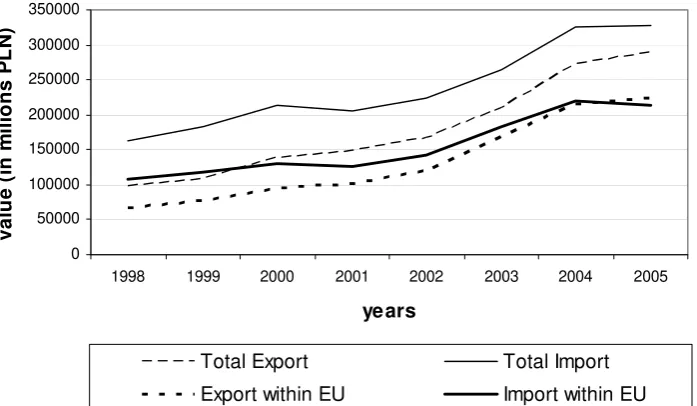Munich Personal RePEc Archive
Impact of the accession to the European
Union on Polish enterprises development
Wach, Krzysztof
Cracow University of Economics
2007
Online at
https://mpra.ub.uni-muenchen.de/31661/
IMPACT OF THE ACCESSION TO THE EUROPEAN UNION
ON POLISH ENTERPRISES DEVELOPMENT1
Krzysztof Wach2
Cracow University of Economics
Department of Entrepreneurship and Innovation 27 Rakowicka Street, 31-510 Kraków, Poland
Introduction
The enlargement of the European Union created new possibilities for Polish entrepreneurs, who can in principle fully use with European freedom of enterprise within 27 Member States of the Community. The enlargement of the European Union is one of the most important events of the beginning of 21st century (Dominiak, Wasilczuk and Daszkiewicz, 2005), which means for Polish enterprises potential advantages, but also threats (Rogut, 2002). The increasing number of studies appearing after the enlargement reflects in this range the clear fragmentariness of scientific knowledge. In the post-accession period there are mainly theoretical publications or these having utilitarian character, whereas scientific research in this field were realized in pre-accession period yet and they with obvious reasons could not show the actual influence of the accession on the development of Polish enterprises. Such analyses, even if they had been conducted, would have been little reliable, as present period of 3 years after the entry of Poland to the European Union really permits now on the qualification of the actual influence of the accession of Poland to the Community. These premises made the author study in this field using own empirical research. The undertaking of investigations has the huge meaning for the discipline of economic sciences. The paper focuses on the influence of the enlargement of the European Union on the development of Polish enterprises.
Theoretical background
The access of Poland to the European Union introduced a great challenge for the business sphere and inhabitants. Polish economy is in present an open economy with a stable internal market and intensive reltions with international markets. From this reason the Polish economical efficiency is sensitive to external environment, it means global trends in the world economy and the development in the European economical space. Main problems of the enterpeises in the several branches of the
1
The paper came into being within the ongoing research project no. 1449/B/H03/2007/33 “Impact of the Accession of Poland to the European Union on the Development of Enterprises in Małopolska Voivodeship” fully financed by the Ministry of Science and Higher Education of the Republic of Poland, project coordinator dr. Krzysztof Wach, Cracow University of Economics, Cracow 2007-2008.
2
national economy in present globalization conditions is the competitiveness of products on the market in connection to the accesses of the enterprises to the financial sources both from several and foreign sources (structural funds, cohesion funds, state budget, etc.).
Enterprises functioning under conditions of progressive European integration as well as globalization of international economy should effectively use all existing possibilities, which are created by integration and globalization processes. Enterprises should search for their competitive advantage by the introduction of Europeanization or internationalization (and even globalization) strategy. Entries on foreign markets can improve the competitive advantage of an enterprise. It is very crucial that the possibilities, which are created for Polish enterprises by the process of political and economic integration in the frame of the European Union became fully used. Europeanization of activities of a firm is one of such possibilities. The well-known theoretician and practitioner of management Peter Drucker confirms it stating that more and more economic units, including small firms, operates as transnational companies (Drucker, 1998, p. 19).
Europeanization of enterprises means internationalizing of their activities in the European scale. Europeanization includes a wide range of behaviours from easy foreign trade transactions to undertaking independent productive activity in a host country. Europeanization of enterprises resulted from the introduction of Single European Market, which guarantees equal rights for all enterprises (including small and medium-sized ones) in all Member Sates (that means mostly the annulment of national protectionism). European market became “local” market offering national entrepreneurs new chances and possibilities.
Opening the discussion on the Europeanization strategy it is crucial to elaborate on motives determining the decision making process on undertaking activities on foreign markets (Wach, 2003). Literature distinguishes two basic motives making enterprises operate on international markets: pull factors (active factors) as well as
push factors (reactive factors). Active motives induce firms to undertake activities
on international scale and are equivalents of pull strategy. The possibility of achievement higher profits on foreign markets is - in this case – the motive of an entry on these markets. This strategy depends on intensifying promotion of particular products in order to achieve larger profits. This strategy focuses on attracting consumers to particular goods (Penc-Pietrzyk, 1999, p. 262). The pull strategy concerns these products, which bring profits on the domestic market. Introducing a given product on foreign markets, a firm expects profits enhancing. Nevertheless push strategy is based on the “thrust” of products of a firm towards consumers by choosing new markets of sales. The firm undertakes activites on foreign markets because of the lack of possibilities on domestic market. Producers' behaviour is very aggressive in this case, which is typical for the push strategy. The OECD report on globalization mentions two different motives additionally, namely
chance factor and entrepreneurial factor (OECD, 1997). The chance factor is
endeavouring to continuous growth. A firm enters new markets in order to achieve further assumed aims.
[image:4.595.77.529.263.636.2]The choice of methods of internationalization depends on both endogenous factors (eg. the competitive potential of a firm) and exogenous ones characterizing the given target market. The choice of methods depends on some objective factors. Literature presents various models explaining the phenomenon of internationalization of enterprises, of which the most popular are stages models, network models and resource-based models. Different forms of entry on foreign markets are characterized by different efficiency, but also different costs of entry. At present stages models of internationalization are beyond, therefore we propose to systematize forms of entry describing intensity of internationalization taking their four degrees into account (table. 1).
Table 1. Intensity, range and forms of internationalization of enterprises
Degree of internationalization intensity Activities / Forms
0. Activity on domestic market • domestic transactions 1. Internationalizing of exchange sphere • import (direct and indirect)
• export (direct and indirect)
• transit trade
• representative office 2. International cooperation links • barter trade
• subcontracting
• piggy-back
• licensing of trade-marks
• franchising
• management contracts
• cooperation contracts
• strategic alliances 3. Running abroad site • branch
• subsidiary
• joint venture
4. Globalization of enterprises • international company
• multinational company
• transnational corporation
• global firm Source: Author’s elaboration
In turn, the abovementioned OECD report constructed the globalization index, which estimates the level of internationalization and/or globalization of studied enterprises. The index was constructed as 10-gradual-scale, in which 5 principal stages of internationalization of enterprises were distinguished (OECD, 1997, p. 22):
• no globalization (domestic firms in the scale from 1 to 2),
• limited globalization (mainly domestic firms in the scale from 3 to 4),
• major globalization (internationalized firms in the scale from 5 to 6),
• extensive globalization (extensively global firms in the scale from 7 to 9),
• full globalization (global firms at the scale of 10).
Material and methods
The main aim of the conducted research is the empirical verification of the influence of the accession of Poland to the European Union on the development of enterprises. The private enterprises regardless of their size (micro -, small-, medium- and large-sized enterprises) are the objects of conducted investigations. Despite the fact, that in the recent years the special attention was attributed to small and medium-sized enterprises, especially in the aspect of European economic integration processes (Daszkiewicz, 2004); (Rogut, 2002); (Dominiak, Wasilczuk and Daszkiewicz, 2005), the Author decided to hug large enterprises as such investigation will allow to show diverse influence of the accession on one hand on the SME sector, and the other hand on large enterprises. Managerial perception was chosen as an operationalization method, thus it assures the acceptable correctness and the reliability, and first of all tops other methods in relation to practical usage, what is more it is applied in analogous research very often (Lyon, Lumpki, Dess, 2000). This method was applied for all qualitative variables (Konecki, 2000, p. 86). Thus a survey (proceeded with a diagnostic pre-survey) was applied as a main investigative technique, replenished with technique of observation. For quantitative variables as operationalization method data analysis was applied. In support of received and accepted variables the questionnaire of inquiry was constructed as a basic investigative tool. Qualitative approach in an inquiry was applied mainly, which is the most often applied approach in analogous investigations.
The own empirical research was conducted on the random sample of 323 enterprises in the first half of the year 2007, that means exactly 3 years after the accession. Such a period allows to make some evaluations and conclusions in this field.
As far as the size of enterprises is concerned, the structure of the research sample embraces:
• 58% of microenterprises (of which 25% self-employed entrepreneurs);
• 24% of small enterprises;
• 13% of medium-sized enterprises.
• 5% of large enterprises.
The average employment in the research sample amounted to 90 persons.
• 50,6% of locally and regionally operating firms,
• 25,2% of nationally operating firms,
• 23,4% of internationally operating firms (of which 13% only within the EU).
Results and discussion
The accession of Poland to the European Union caused the insignificant change in identifying main business rivals of Polish enterprises acting in Małopolska Voivodeship. In both cases, before and after the accession, the main rivals of studied enterprises are other national firms, however their share after the accession fell about 15% (from 82.7 % to 69.9 %), whereas foreign rivals' share as well as Polish enterprises with foreign capital grew up at least twice (suitably from 7.7 % to 15.2 % and from 2.9 % to 11.2 %).
The competitive advantage of studied enterprises on domestic market in principle did not undergo the changes, in opinion of more than a half of studied firms in both cases before and after the accession, was defined as average, however in the opinion of near 1/4 of studied enterprises as strong. Nevertheless the competitive advantage
of studied enterprises got better on European market. The percentages of firms, which perceive themselves as competitive on European markets grew up (from 43.3% to 52.2 %), whereas the percentage of firms considerate themselves as not being able effectively to compete on European markets dropped (from 16% to 10.6%). More than 3/4 of studied enterprises indicate the cost superiority as the
reason of good competitive advantage.
The accession to the European Union resulted also in the improvement of external financial sources for Polish enterprises. As many as 3/4 of studied enterprises
applied for the EU structural funds, more than a half of which got accepted (figure 1)
70,5
16,1
13,4
29,5
studied enterprises who did not apply for a subsidy
studied enterprises who applied for a subsidy and got accepted
[image:6.595.152.464.533.709.2]studied enterprises who applied for a subsidy and were not accepted
Figure 1. Usage of the EU structural funds among studied enterprises(in %)
In the opinion of the majority of studied entrepreneurs, the accession of Poland to the European Union had positive influence (58.9%), what is more the total minority only indicates the negative results of the accession (7.3%). In the opinion of respondents the profitable influence on the functioning of the studied enterprises in significant degree played:
• freedom of movement for goods (43.1%),
• freedom of movement for services (20.1%),
• freedom of establishment (18.6%),
• freedom of movement for workers (11.6),
• freedom of movement for capital (6.6%).
Partial results in this aspect are also very interesting. Using the abovementioned methodology of OECD concerning the degree of internationalization of enterprises, one should affirm, that in the studied community the degree of internationalizing measured with the OECD index of globalization was as follows:
• 84,4% makes domestic firms (no globalization),
• 10,4% makes mainly domestic firms (limited globalization),
• 1,5% makes internationalized firms (major globalization),
• 3,7% makes global firms (full globalization)3.
Taking it differently by using introduced above the classification of the intensiveness of internationalization it is necessary to state that 65% of the studied enterprises did not undertake any activities on international markets, however among the remaining as many as 15% undertook such activities after the accession of Poland to the European Union (figure 2). What is worth noticing, most of them, undertook export activities (29.4%), but also cooperation with foreign partners (27.3%) as well as beginning to import products or service from the remaining countries of the Community (23.7 %). The plans of the studied enterprises in the range of Europeanization are convergent to the current level of Europeanization of studied enterprises, however with considerable share of cooperation with foreign partners (figure 3). These results can prove positive influence of the EU accession on the level of Europeanization of Polish enterprises as well as the tendency to retain this state of art.
3
29,4
23,7
6,2
8,2
2,1
27,3
3,1
0 5 10 15 20 25 30 35
export import representative office
[image:8.595.127.485.78.294.2]branch subsidiary cooperation others
Figure 2. Europeanization activities conducted after the EU accession (in %)
Source: Author’s elaboration on the basis of own empirical research
27,4
14,2
6,6
3,6
1,0
44,7
2,5
0 5 10 15 20 25 30 35 40 45 50
export import representative office
[image:8.595.125.490.373.591.2]branch subsidiary cooperation others
Figure 3. Plans for Europeanization activities within next 12 months (in %)
Source: Author’s elaboration on the basis of own empirical research
As much as 27% of studied enterprises underwent export activities. The share of export in incomes of the studied exporters was diversified. In this group:
• among 41.4% of studied exporting firms did not exceed 10%,
• among 20.7% of studied exporting firms amounted to 11-25%,
• among 24.1% of studied exporting firms amounted to 26-50%,
Nearly a half of the studied exporters led export activity within the European Union, the same number of studied firms exported both within and outside the Community, only 2.3% of studied exporters led export activity only outside the European Union. The results of investigations are positive as far as the influence of the accession on the size of led export activities is concerned. More than 2/3 of the studied enterprises
noted the growth of export share in incomes after the accession (figure 4).
16,5
52,4
27,2
2,9
1,0
0 10 20 30 40 50 60
[image:9.595.145.466.180.374.2]extremly increase rather increase no change rather decrease extremly decrease
Figure 4. Changes of export share in incomes of studied enterprises as the result of the accession (in %)
Source: Author’s elaboration on the basis of own empirical research
export partners are Germany, then France, Italy and Great Britain. The main Polish import partners from the EU are Germany, then Italy, France. One of the European crucial partners is the Czech Republic (credit balance). Germany is unquestioned Polish foreign trade partner. The value both export and import is indisputable (at least five times bigger than for other EU partners). Moreover the surplus is noted (credit balance). The comparison of foreign trade turnover in the period before and after the accession shows significant growth of turnover in the post accession period, both in general formulation and especially within the European Union. The provided analyses of statistical data allows to prove the hypothesis that accession of Poland to the European Union had positive impact of foreign trade not only in the field of the value of export, but what is more it resulted in reducing the total debit foreign trade balance as well as in credit foreign trade balance within the European Union countries (Czaja and Wach, 2007).
0 50000 100000 150000 200000 250000 300000 350000
1998 1999 2000 2001 2002 2003 2004 2005
years
v
a
lue
(
in m
il
ion
s
P
L
N
)
Total Export Total Import
[image:10.595.135.484.278.481.2]Export within EU Import within EU
Figure 6. Foreign Trade Turnover of Poland in 1998-2005(in millions of PLN)
Source: Author’s calculations based on data of Central Statistical Office of Poland
On the other hand, the results of own empirical research concerning non-exporting activities is also interesting. These firms, which did not undertake any internationalizing activities, in predominant majority indicated the lack of such a need (80.6%), alternatively the lack of knowledge in this range (6.7%) as the reason of that. They were mainly the smallest firms, which act on local markets, which can not be surprising. Only 5.7% of the studied enterprises indicated formal difficulties as the reason of not undertaking Europeanization activities.
Reactive motives (push factor) played scarce part (2.4%). This results may testify on one hand of the maturity of the studied enterprises, on the other hand of the utilization of potential chances, which were brought by the accession of Poland to the European Union.
Conlusions
Recapitulating, the current situation creates potential and almost unrestricted possibilities of creating the new value of Polish enterprises on European markets. Preliminary governmental statistics as well as the presented results of own empirical research show, that Polish entrepreneurs successfully use possibilities created by the common market: they Europeanize their activities by increasing foreign trade transactions, but more and more bravely they make use of the European freedom for establishment.
The presented results of own empirical research make up the basis for verifying common opinions on the influence of the accession on Polish enterprises, they shows active attitudes of Polish entrepreneurs towards European markets. However it is crucial to underline that they are only the preliminary results of the research, which should be the subject of further statistical analysis and verification in order to find and prove correlations among individual variables.
References
Czaja, I. and Wach, K. 2007:, ‘Zmiany obrotów handlu zagranicznego Polski w okresie przed- i poakcesyjnym do Unii Europejskiej’, in: „Zeszyty Naukowe”, Wydawnictwo Uniwersytetu Ekonomicznego w Krakowie, Kraków (in printing). Daszkiewicz, N. 2004: Internacjonalizacja małych i średnich przedsiębiorstw we współczesnej gospodarce, Scientific Publishing Group, Gdańsk.
Dominiak, P., Wasilczuk, J. and Daszkiewicz, N. 2005: Małe i średnie
przedsiębiorstwa w obliczu internacjonalizacji i integracji gospodarek
europejskich. Przykłady Włoch, Francji, Polski i Czech, Scientific Publishing
Group, Gdańsk.
Drucker, P. 1998: ‘W kierunku organizacji nowego typu’, in: F. Hesselbein, M. Goldsmisth, R. Beckhard (ed.), Organizacja przyszłości, Business Press, Warszawa.
Horská, E., Ubrežiová, I. and Wach, K. 2007:, ‘Foreign Trade Changes in Poland and Slovakia as an Effect of Europeanization Before and After the Accession’, in:
The Path of Internationalization and Integration in the Europe of Regions.
Scientific Papers, Faculty of Economics and Management, Slovak University of
Agriculture, Nitra.
Lyon, D.W., Lumpkin, G.T. and Dess, G.G. 2000:, ‘Enhancing Entrepreneurial Orientation Research: Operationalizing and Measuring a Key Strategic Decision Making Process’, Journal of Management, no. 5.
Morawczyński, R. and Wach, K. 2003: ‘Impact of the EU accession on Polish small and medium-sized enterprises’, in: Small and medium enterprises in European
economies, International Conference Proceedings, Babes-Bolyai University Cluj
Napoca, Faculty of Business, Romania, Editura Alma Mater, October 17-18, 2003. Naisbitt, J. 1995: Global Paradox, Routledge Publishing, London.
OECD 1997: Globalisation and Small and Medium Enterprises, Paris.
Penc-Pietrzyk, I. 1999: Strategie biznesu i marketingu, Wydawnictwo Profesjonalnej Szkoły Biznesu w Krakowie, Kraków 1999.
Pichur, A. and Wach, K. 2007: ‘Influence of the European Enlargement Process on Entrepreneurship in Poland’, in: Small and medium enterprises in European
economies and all over the world, International Conference Proceedings,
Babes-Bolyai University Cluj Napoca, Faculty of Business, Romania, Editura Alma Mater, September 26-28, 2007.
Rogut, A. 2002: Małe i średnie przedsiębiorstwa w integracji ekonomicznej.
Doświadczenia Unii Europejskiej. Lekcje dla Polski, seria: „Rozprawy
Habilitacyjne”, Wydawnictwo Uniwersytetu Łódzkiego, Łódź.
Wach, K. 2003: ‘Strategia globalizacji jako jeden z efektów walki konkurencyjnej przedsiębiorstw, in: „Zeszyty Naukowe”, nr 622, Wydawnictwo Akademii Ekonomicznej w Krakowie, Kraków.
Wach, K. 2005: Systemy podatkowe krajów Unii Europejskiej, Oficyna Ekonomiczna, Kraków.
Wach, K. 2006: Jak założyć firmę w Unii Europejskiej, wyd. III, Wolters Kluwer Polska, Kraków 2006.
Wach, K. 2007: Europejski rynek pracy, Wolters Kluwer Polska, Kraków 2007. Wach, K. (ed.) 2005: Działalność gospodarcza w Unii Europejskiej. Wybrane
zagadnienia, Akademia Ekonomiczna w Krakowie, Kraków.
SOURCE:
K. Wach, Impact of the Accession to the European Union on Polish Enterprises
Development [in:] VI. Nemzetközi Konferencja A közgazdász képzés megkezdésének 20. évfordulója alkalmából (Conference Proceedings of 6th International Conference organized in the
XX annual of Faculty of Economics), II. kötet (volume II), ed. A. Somogyi, Miskolci Egyetem -




